From Nephthys, the ancient Egyptian deity who protected mummies, to the Aztec "Lady of the Dead," who continues to play a role in modern festivals, discover history's most fascinating goddesses of death.
Essentially every culture throughout history has turned to a higher power. Some faiths honor just one omniscient, omnipotent God. Others pray to a variety of deities who control all aspects of life, from gods of fire, wine, and the seas to goddesses of death.
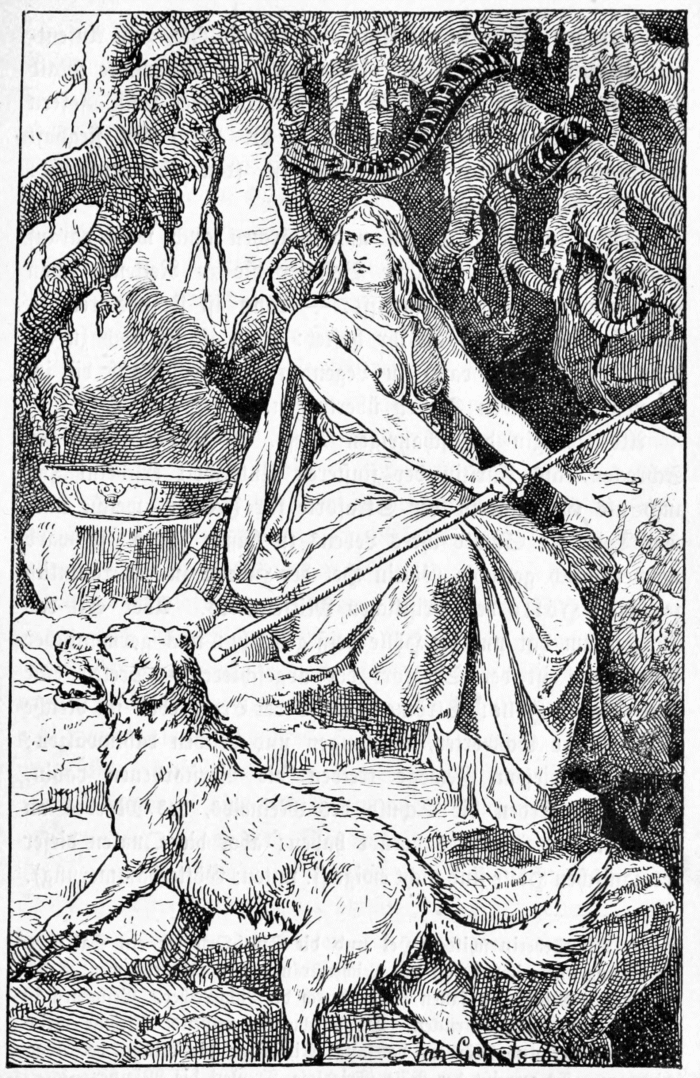
Public DomainFrom Norse mythology to modern festivals, death goddesses have long played a key role in religious and cultural practices.
These death goddesses were as varied as the cultures who worshipped them. They played different roles, such as overseer of the Underworld, protector of mummies, and determiner of fate.
While some were more benevolent than others, they all had one thing in common: They were associated with the end of life and the mysteries that come along with it.
From the jungles of Mesoamerica to the wine-dark seas of ancient Greece, these goddesses of death were believed to have a hand in humanity’s greatest unknown.
Hel, The Death Goddess Of Norse Mythology
Hel, the Norse goddess of death, was so enmeshed with the world of the dead that she shared a name with it. She ruled over the underworld realm of Hel, also known as Helheim or Niflheim.
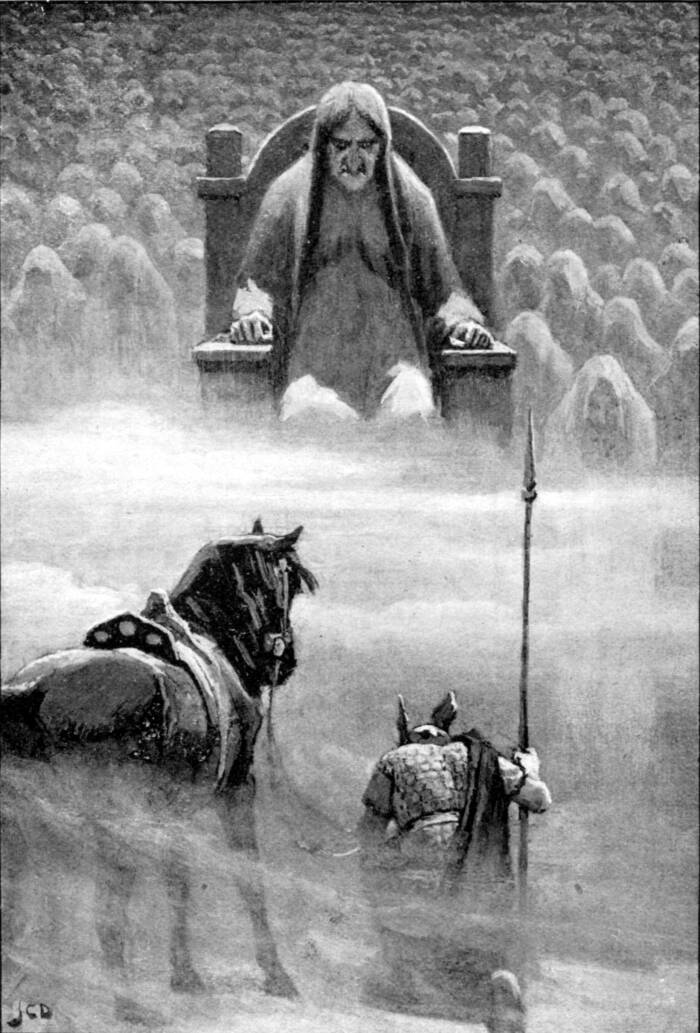
Public DomainThe Norse death goddess Hel sitting on her throne in Helheim.
The Norse word hel was derived from a Germanic term meaning “concealed place” or “the underworld,” sharing the root with the modern English word “Hell.”
Hel the death goddess was a daughter of Loki, the trickster deity of Norse mythology. According to the 13th-century Prose Edda, Hel was sent to the underworld by Odin: “Hel he cast into Niflheim, and gave her power over nine worlds, that she should appoint abodes to them that are sent to her, namely, those who die from sickness or old age.”
Whereas warriors who died in battle spent eternity in Valhalla, anyone who died from natural causes went to Hel. In her domain, she had “a great mansion, and the walls around it are of strange height, and the gates are huge.” She also had many servants.
Hel was half blue and half flesh-colored, with “very stern and grim” looks. As the overseer of Helheim, she played a role in several Norse myths, most prominently in the attempted resurrection of the god Baldr. In the tale, Hel agrees to allow Baldr to leave the underworld if every object — alive and dead — weeps for him.
One giantess refused to cry, however, and Hel stuck to her word and kept Baldr in Helheim, proving her worth as the ultimate Norse goddess of death.
Kali, The Hindu Goddess Of Death And Destruction
In contrast to Hel’s calm and fairly neutral overseeing of the underworld, the Hindu deity Kali was distinctly bloodthirsty.
Kali stands for many things to her worshippers in the Indian subcontinent, including time, doomsday, motherly love, and death. The companion of Shiva, Kali represents the unity in birth and death and acceptance in the face of destiny.
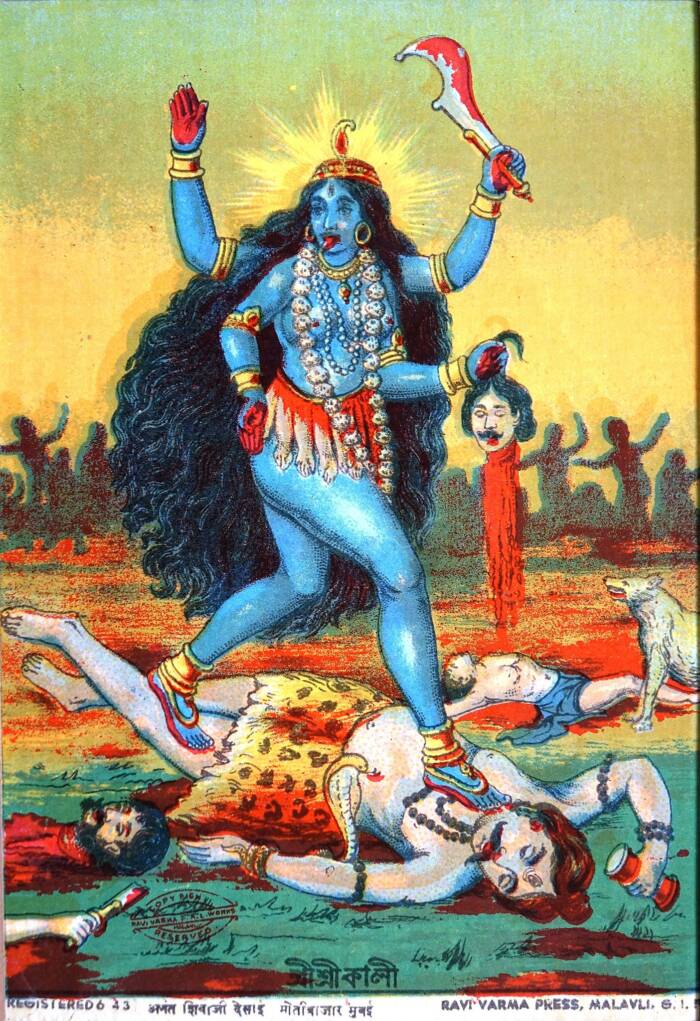
Ravi Verma Press/Wikimedia CommonsThe Hindu goddess of death and destruction is often depicted standing on her husband, Shiva.
However, she is no peace-loving goddess. She demands sacrifices of her worshippers, to the point that the scarlet hibiscus bloom is considered sacred to her for its blood-red appearance.
Kali’s appearance is familiar. One of the most striking gods in the Hindu pantheon, she is typically portrayed with black or dark blue skin, many arms, and a frightening face with a lolling tongue that she uses to lap up blood. While often drawn naked, Kali also sports two accessories: a necklace made of skulls and a skirt of human arms.
With over a billion followers of Hinduism, this goddess of death is far from a footnote.
The Aztec ‘Lady Of The Dead’ Mictēcacihuātl
Deep in the jungles of Mesoamerica, the Aztecs worshipped Mictlāntēcutli and Mictēcacihuātl, the god and goddess of death. Often depicted with flayed skin, popping eyeballs, and gawping faces, these deities commanded respect as well as fear.
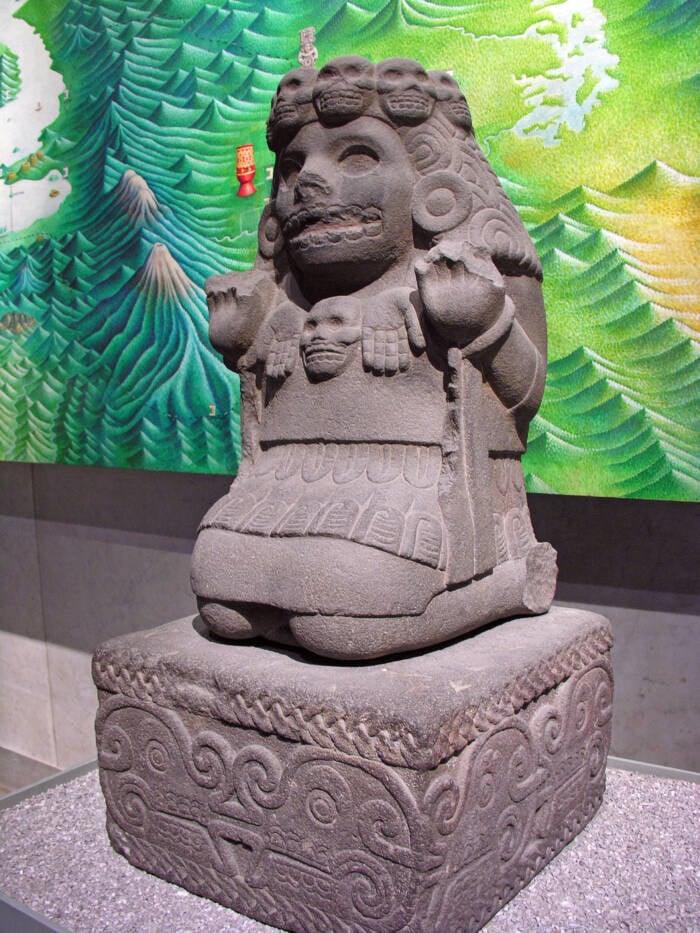
Dennis G. Jarvis/Wikimedia CommonsA statue of Mictēcacihuātl, the Aztec Lady of the Dead.
The divine couple ruled over the dismal underworld realm of Mictlān. Souls had to pass through eight levels of challenges to reach Mictēcacihuātl and her partner, from a field of knives to a river of blood.
Called the “Lady of the Dead,” Mictēcacihuātl protected the bones of the dead so they could be used again in the land of the living. The goddess of death also presided over annual festivals of the dead, inspiring dancing and feasts of thanks from the Aztecs.
Taking advantage of the shared crossover between the sacred feminine and death, Spanish conquistadors merged the worship of Mictēcacihuātl with All Saints’ Day, resulting in the modern Día de los Muertos, or Day of the Dead.
Keres, The Vengeful Female Spirits Of The Dead
In Greek mythology, the queen of the underworld is Persephone, the goddess of spring and the wife of Hades.
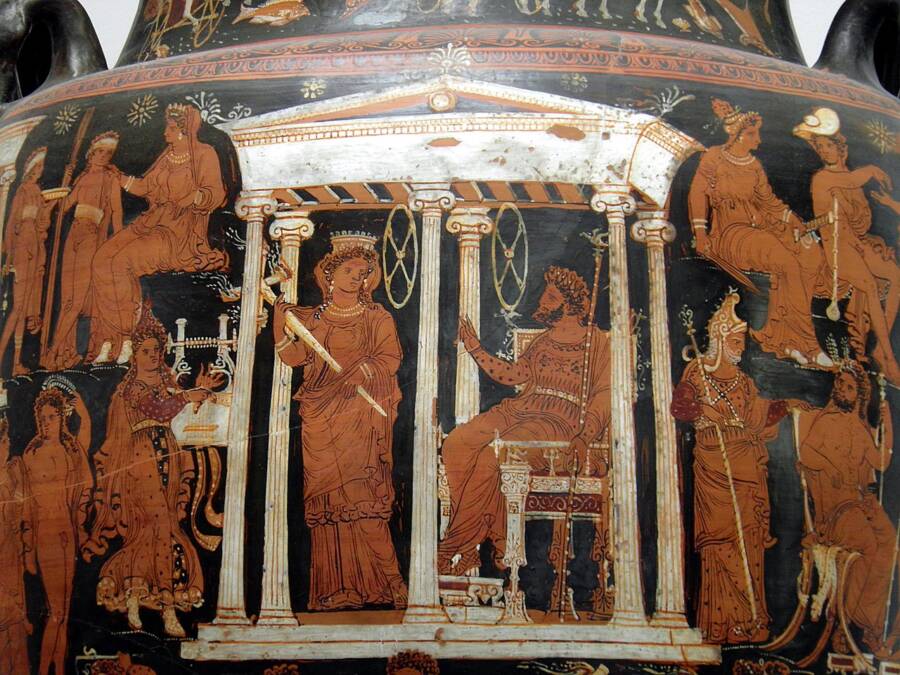
Carole Raddato/Wikimedia CommonsA depiction of Hades, to whom victims of violent death would descend after the Keres had feasted on them.
However, there were other deities related to death itself. Keres were the children of Nyx, the goddess of night, and they were particularly associated with violent ends. They hovered over battlefields, waiting for their chance to swoop down and devour the dying men below.
In Shield of Heracles, the Greek poet Hesiod gives a grisly description of Keres:
“The black Dooms gnashing their white teeth, grim-eyed, fierce, bloody, terrifying fought over the men who were dying, for they were all longing to drink dark blood. As soon as they caught a man who had fallen or one newly wounded, one of them clasped her great claws around him and his soul went down to Hades… And when they had satisfied their hearts with human blood, they would throw that one behind them and rush back again into the battle and the tumult.”
Keres didn’t actually have the power to kill humans, but another Greek goddess of death did.
The Three Fates of Greek mythology — Clotho, Lachesis, and Atropos — played a key role in the lives of every human. Their Roman equivalents were Nona, Decuma, and Morta.
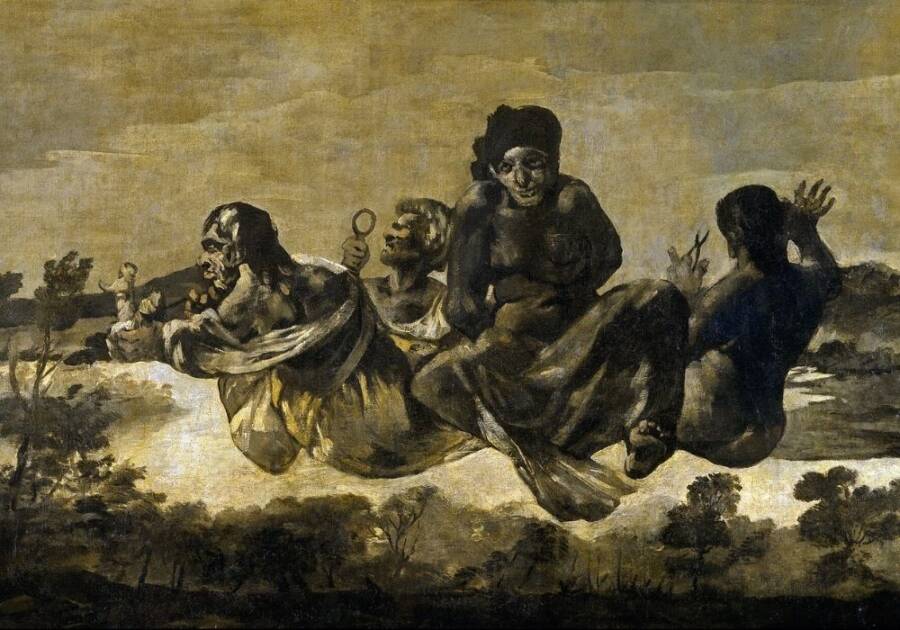
Public DomainFrancisco Goya’s 1820s depiction of the Fates.
Clotho determined someone’s fate by spinning the “thread” of life, Lachesis measured the thread to decide how long their life would be, and Atropos chose the manner of death and was the one to cut the thread at the very moment of someone’s demise.
While these Greek deities were present for the act of death, the Egyptian goddess Nephthys didn’t step in until after a body was preserved.
Nephthys, The Protector Of Mummies
Along the Nile, death was serious business. Considered the embarkation of a sacred journey to the afterlife, death was only the beginning before a resurrection elsewhere. The phenomenon of mummification echoed the ancient Egyptian preoccupation with rebirth, symbolized by the ebb and flow of the life-giving Nile. With this obsession with death, resurrection, and the proper care of the deceased came a coterie of gods and goddesses of death.

Washington State History Museum/Wikimedia CommonsAncient Egyptian death goddess Nephthys depicted on a sarcophagus.
One such figure was Nephthys. Meaning “mistress of the house,” this Egyptian death goddess was the sister of Isis and sister-wife of Osiris. She was also sometimes depicted as the wife of Set, who murdered Osiris by locking him in a chest and throwing him into the river. While Osiris was being resurrected by Isis, Set engaged in a power struggle with Horus, one of ancient Egypt’s most important deities.
In this epic struggle between good and evil, Nephthys was allied with Osiris, mourning his death with Isis and helping her resurrect him. For her part in the first real funeral, this goddess of death was often depicted on canopic jars and outside tombs to protect the bodies of the dead in the afterlife.
Nephthys is also typically considered to be the mother of the jackal-headed Anubis, a god of the underworld. She was associated with vultures and often depicted as a woman in perpetual mourning.
From vengeful spirits to maternal protectors to seductresses (and often a mix of all three), the mysteries of death have long been represented by female divinities. Echoing or contrasting the place of women in their societies, these fascinating goddesses of death were taken very seriously by their worshippers.
After reading about these goddesses of death, learn about Freya, the Norse goddess who welcomed slain heroes to the afterlife. Then, go inside the story of Morrígan, the goddess of fate, war, and death in Irish folklore.





